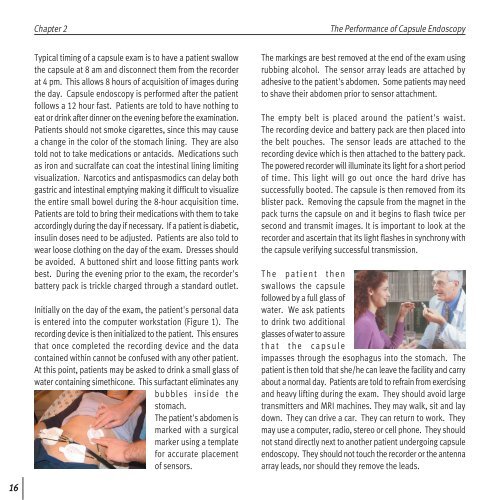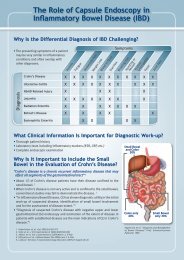capsule experience - MG Lorenzatto
capsule experience - MG Lorenzatto
capsule experience - MG Lorenzatto
Create successful ePaper yourself
Turn your PDF publications into a flip-book with our unique Google optimized e-Paper software.
16<br />
Chapter 2<br />
Typical timing of a <strong>capsule</strong> exam is to have a patient swallow<br />
the <strong>capsule</strong> at 8 am and disconnect them from the recorder<br />
at 4 pm. This allows 8 hours of acquisition of images during<br />
the day. Capsule endoscopy is performed after the patient<br />
follows a 12 hour fast. Patients are told to have nothing to<br />
eat or drink after dinner on the evening before the examination.<br />
Patients should not smoke cigarettes, since this may cause<br />
a change in the color of the stomach lining. They are also<br />
told not to take medications or antacids. Medications such<br />
as iron and sucralfate can coat the intestinal lining limiting<br />
visualization. Narcotics and antispasmodics can delay both<br />
gastric and intestinal emptying making it difficult to visualize<br />
the entire small bowel during the 8-hour acquisition time.<br />
Patients are told to bring their medications with them to take<br />
accordingly during the day if necessary. If a patient is diabetic,<br />
insulin doses need to be adjusted. Patients are also told to<br />
wear loose clothing on the day of the exam. Dresses should<br />
be avoided. A buttoned shirt and loose fitting pants work<br />
best. During the evening prior to the exam, the recorder's<br />
battery pack is trickle charged through a standard outlet.<br />
Initially on the day of the exam, the patient's personal data<br />
is entered into the computer workstation (Figure 1). The<br />
recording device is then initialized to the patient. This ensures<br />
that once completed the recording device and the data<br />
contained within cannot be confused with any other patient.<br />
At this point, patients may be asked to drink a small glass of<br />
water containing simethicone. This surfactant eliminates any<br />
bubbles inside the<br />
stomach.<br />
The patient's abdomen is<br />
marked with a surgical<br />
marker using a template<br />
for accurate placement<br />
of sensors.<br />
The Performance of Capsule Endoscopy<br />
The markings are best removed at the end of the exam using<br />
rubbing alcohol. The sensor array leads are attached by<br />
adhesive to the patient's abdomen. Some patients may need<br />
to shave their abdomen prior to sensor attachment.<br />
The empty belt is placed around the patient's waist.<br />
The recording device and battery pack are then placed into<br />
the belt pouches. The sensor leads are attached to the<br />
recording device which is then attached to the battery pack.<br />
The powered recorder will illuminate its light for a short period<br />
of time. This light will go out once the hard drive has<br />
successfully booted. The <strong>capsule</strong> is then removed from its<br />
blister pack. Removing the <strong>capsule</strong> from the magnet in the<br />
pack turns the <strong>capsule</strong> on and it begins to flash twice per<br />
second and transmit images. It is important to look at the<br />
recorder and ascertain that its light flashes in synchrony with<br />
the <strong>capsule</strong> verifying successful transmission.<br />
The patient then<br />
swallows the <strong>capsule</strong><br />
followed by a full glass of<br />
water. We ask patients<br />
to drink two additional<br />
glasses of water to assure<br />
that the <strong>capsule</strong><br />
impasses through the esophagus into the stomach. The<br />
patient is then told that she/he can leave the facility and carry<br />
about a normal day. Patients are told to refrain from exercising<br />
and heavy lifting during the exam. They should avoid large<br />
transmitters and MRI machines. They may walk, sit and lay<br />
down. They can drive a car. They can return to work. They<br />
may use a computer, radio, stereo or cell phone. They should<br />
not stand directly next to another patient undergoing <strong>capsule</strong><br />
endoscopy. They should not touch the recorder or the antenna<br />
array leads, nor should they remove the leads.




